|
VI.
PLANT COMMUNITIES
E. GRASSLANDS
Grasslands
are distributed worldwide. In California they are
found from Oregon to the Mexican border and from the
desert to the Pacific Ocean. They occur here from
sea level to about 4500 feet. In the northwestern
corner of the state, primarily on coastal terraces
and hills, one finds Coastal Prairies or Northern
Coastal Grasslands. Montane meadows are
usually treated as wetland communities given the distinctively
wet environment in which they occur. In transmontane
California (east of the Sierra Nevada Mountains) in
the Mojave and Great Basin Deserts are Desert Grasslands.
Throughout the rest of cismontane California are Southern
Coastal Grasslands, Valley Grasslands,
and Native Bunchgrass Grasslands. Today, Valley
Grasslands , California annual grasslands , or non-native
grasslands, are synonymously used to refer to most
of the highly altered grasslands found throughout
California. They occur in the San Joaquin, Sacramento,
and Salinas Valleys and other similar valleys, as
well as along the coast. Poly Canyon's grasslands
are within the geographic extension and floristic
description of Valley Grasslands and Native Bunchgrass
Grasslands. Today Valley Grasslands are largely dominated
by introduced annual grasses and forbs. Native Bunchgrass
Grasslands are supposed relicts of the pristine valley
grassland and are dominated by native perennial bunchgrasses.
Valley
Grasslands and Native Bunchgrass Grasslands occur
in areas of relatively little (ten to twenty inches)
rain that falls, irregularly, in winter and spring.
Typically there are four to eight months per year
of summer drought when the soils dry out thoroughly.
Temperatures often rise above 100°F. These areas are
too hot and dry for woodlands and forests. However,
where more moisture is available, often on north-facing
slopes, in ravines, or near springs, trees such as
coast live oaks (Quercus agrifolia) may grow
among the grasses and forbs.
These
grasslands develop on a variety of soils. As their
name suggests, Valley Grasslands are often found in
valleys on deep, nutrient-rich alluvium. The soil
texture ranges from coarse gravel to very fine clay.
A shallow claypan or hardpan may prevent rain from
penetrating to deeper soil horizons. Native Bunchgrass
Grasslands are often found on shallow and/or rocky,
nutrient-poor serpentinite or in patches among Valley
Grasslands. During the summer, the upper soil horizons
of these grasslands usually dry out.
Grassland
communities in Poly Canyon intergrade with coastal
scrub, chaparral, coastal live oak woodlands, and
riparian communities. Grasslands and coastal scrub
may both occur on clay soils and are often physically
separated by a zone of bare ground, as discussed above
in the coastal scrub chapter. Chaparral tends to be
found on steeper slopes. Coastal live oak woodlands
are found in soils that retain moisture longer.
A
description of California's pre-European pristine
grassland communities is impossible because there
are no scientifically accurate records. Experts use
early historical accounts in conjunction with knowledge
of micro-fossil presence and current grassland composition
and distribution to attempt to describe what these
grasslands once may have been. In areas where soils
retain more moisture later into spring and early summer,
primarily in rich-soiled valley bottoms and lower
foothills, one often finds perennial grasses such
as needlegrasses (Nassella pulchra and N.
cernua, both bunchgrasses). These are often interspersed
with non-native annual grasses such as wild oats (Avena
spp.) and bromes (Bromus spp.). Other native
grasses are also common, including one-sided bluegrass
(Poa secunda), blue wild-rye (Elymus glaucus),
Junegrass (Koeleria macrantha), and melic grasses
(Melica spp.). Annual grasses and forbs commonly
occupy open spaces among the perennials.
Pre-colonial
native grasslands were grazed seasonally and episodically
by pronghorn antelope, tule elk, and deer. The valley
floor would be grazed earliest in the year. Then,
as temperatures warmed the foothills and grasses matured
there, the herds would move further and further upslope
till the cool weather returned. Predators would have
kept the number of grazers in check and kept the remaining
animals on the move. Thus, the habitat would unlikely
have been overgrazed.
Native
Californians used fire once every three to five years.
Fire stimulates the regrowth of certain herbs and
grasses the following year by removing litter, providing
more nutrients in the form of ash, and preserving
the grassland community by preventing woody plants
from becoming established. For example, purple needlegrass
(Nassella pulchra) seedlings become established
more successfully on bare ground than on the litter-strewn
ground of an undisturbed grassland. Also, studies
have shown that perennial grassland species successfully
resprout and vigorously set flower the first season
following burning.
From
1769 through the mid-1800s, Europeans settled and
changed these grasslands for raising introduced crops
and domestic livestock. European methods of animal
husbandry encouraged cattle and sheep to graze much
more intensively than native animals. Domestic animals
were allowed to graze throughout the year. Fires were
either repressed or set too often (yearly). European
forbs, such as filaree (Erodium spp.), mustard
(Brassica spp. and Hirschfeldia incana),
and thistles (Carduus pycnocephalus, Centaurea
calcitrapa, Cirsium vulgare, Silybum
marianum, and others), were mostly introduced
accidentally, their seeds arriving in livestock and
pet hooves, fur, and fodder, as well as in packing
materials and ballast. These foreign plants came to
California's Mediterranean climate without elements
which in Mediterranean Europe kept their growth in
check. Their native pests and diseases remained in
their homeland making them already more tolerant of
grazing than were native Californian plants. Also,
European cattle and sheep preferred grazing on native
Californian plants. Thus, the introduced plant species
that were able to survive then, now grow here unchallenged:
hardy weeds.
Among
forbs and grasses, introduced grassland annuals seem
to challenge the native perennials. Annuals germinate
with the first rains of the season and start growing
earlier in the year than perennials. Annuals take
the first moisture and nutrients available in an area.
Then they grow quickly to outshade perennial species.
Many annuals are not as tasty as perennials or they
have other qualities which repel livestock. For example,
the common name ripgut grass (Bromus diandrus)
refers to the long, sharp awns (bristly hairs which
stick out of the grass head) that would-be grazers
need to negotiate before eating any kernels. Many
annuals have much lower nutritional value than perennials,
and annuals are available to be grazed only in spring,
whereas perennials remain green nearly year-round.
Type
conversion not only of native grasslands, but also
of coastal scrub and chaparral has claimed many acres
for fields, orchards, and urbanization. Wild oats
(Avena spp.), bromes (Bromus spp.),
and barley (Hordeum spp.) are commonly found
in such areas. However, localized occurrences of native
perennials such as needlegrass (Nassella spp.),
bent grass (Agrostis spp.), fescue (Festuca
spp.), Junegrass (Koeleria macrantha), and
bluegrass (Poa spp.) are also found. Section
G provides more information on anthropogenic communities
(click here for description).
Once
covering one fifth of the state, native perennial
grasslands cover 0.1% of that today. "The California
Natural Diversity Data Base has identified Purple
Needlegrass [Nassella pulchra] Grassland as
a community which needs priority monitoring and restoration
efforts. Communities with 10% or greater overall cover
of Stipa pulchra [Nassella pulchra]
constitute significant communities that require special
protection as remnants of the once widespread pristine
California prairie."
At
Cal Poly, an innovative approach to range management
has been applied in Serrano Canyon, the watershed
just west of Poly Canyon. Under the title "holistic
resource management," livestock grazing is proving
to be not only sustainable, but more importantly,
beneficial to degraded grassland communities. At any
given time, 100% of the animals are grazing on only
1% of the available land. Animals are not allowed
to graze an area until all forage has been depleted.
Instead they are rotated into other pastures soon
enough to allow native grasses and forbs the opportunity
to regenerate. Pastures are closely monitored and
are grazed much like they were when native deer were
their only grazers: periodically and episodically.
Depending on the season and the weather patterns,
animals are grazed longer or shorter in any given
area.
In
Poly Canyon, Italian thistle has become established
under many oaks because of repeated cattle trampling
and overgrazing. Ironically, cattle no longer graze
areas that have become overrun by the thistles. However,
sheep do. Sheep eat plants that cattle will not touch,
such as star thistles (Centaurea spp.), Italian
thistle (Carduus pycnocephalus), and milk thistle
(Silybum marianum). With the managed introduction
of sheep into such areas in Serrano Canyon, Italian
thistle has been eliminated, promoting reestablishment
of more desirable native grasses and forbs.
Another
interesting point is that many studies have shown
oak survival to be inhibited by rodent populations
in savannas and grasslands. However, studies in Serrano
Canyon suggest that the rodents are not actually the
cause of the problem, rather a symptom of another
problem. As native perennial grasses and forbs are
replaced by introduced annuals, the overall seed production
in the area increases. This allows the population
of seed-eating rodents to increase proportionately.
While perennials produce seed over a relatively longer
period each year (well into summer), annuals produce
only one crop of seeds each year mostly in one short
season (late spring, early summer). When annuals dominate
a savanna, acorns, which mature when annual seed is
long gone, become an important food crop for the rodents,
and the recruitment of oaks suffers.
In
Poly Canyon, non-native annual grasslands occur primarily
in the deeper-soiled, clay-loam bottomlands bordering
riparian communities and on the lower hillsides where
they meet coastal live oak woodlands, chaparral, and
coastal scrub communities. They constitute grazed
lands, pastoral communities highly modified by human's
repeated disturbance.
The
occurrence of native perennial grasses on shallow-soiled,
rocky, serpentinitic hillsides is conspicuous in Poly
Canyon. Grazing of domestic livestock has been eliminated
in some of these areas. Patches occurring within the
boundaries of the Botanic Garden have not been grazed
since 1971. One such area supports at least seven
grass species, the first six of which are natives:
- Squirreltail
(Elymus elymoides), perennial
- Junegrass
(Koeleria macrantha), perennial
- California
melic (Melica californica), perennial
- Slender
needlegrass (Nassella lepida), perennial
- Purple
needlegrass (Nassella pulchra), perennial
- Annual
fescue (Vulpia microstachys), annual
- Ryegrass
(Lolium perenne), annual
Whereas
many native grasses are tolerant of serpentinitic
soils, most non-native annuals are unable to withstand
such an environment. In Poly Canyon, serpentinitic
uplands are haven to relict native grasslands as well
as communities of rock outcrop and yucca scrub.
- Native
grasses commonly found in Poly Canyon include:
- Blue
wild-rye (Elymus glaucus)
- Junegrass
(Koeleria macrantha)
- Beardless
wildrye (Leymus triticoides)
- Melic
grass, oniongrass (Melica imperfecta)
- Foothill
or slender needlegrass (Nassella lepida)
- Purple
needlegrass (Nassella pulchra)
- One-sided
bluegrass (Poa secunda)
-
Annual fescue (Vulpia microstachys)
- Grasses
introduced to Poly Canyon include:
- *Slender
wild oat (Avena barbata)
- *Common
wild oat (Avena fatua)
- False
brome (Brachypodium distachyon)
-
- Ripgut
brome (Bromus diandrus)
- Soft
chess brome (Bromus hordeaceus)
- Red
brome, foxtail chess (Bromus madritensis)
- Nit
grass (Gastridium ventricosum)
- Mediterranean
barley (Hordeum marinum ssp. gussoneanum)
- *Foxtail
(Hordeum murinum)
- *Wild
rye, Italian ryegrass (Lolium multiflorum)
- Harding
grass (Phalaris aquatica)
- Smilo
grass (Piptatherum miliaceum)
-
Annual bluegrass (Poa annua)
-
Rattail fescue (Vulpia myuros)
Descriptions
of Poly Canyon's primary native grasses follow.
|
image
unavailable
Blue
wild-rye (Elymus glaucus) This bunchgrass
is a stiffly erect perennial with a grayish-bluish
green color. It has 6- to 14-dm. (231/2- to
55-inch) culms. The leaf blades are flat. The
6- to 16-cm. (21/2- to 61/2-inch) spike-like
inflorescence generally has two spikelets per
node. Each spikelet has one to seven florets.
The straight awn is less than 30 mm. (11/4 inches)
long. Blue wildrye occurs in open areas, chaparral,
and woodlands.
Elymus
is the ancient Greek name for this grass. Glaucus
means "bluish-gray."
|
|
image
unavailable
Junegrass
(Koeleria macrantha) This is a perennial,
clumping species. It has 2- to 7-dm. (8- to
271/2-inch) stems. The leaves have ridged blades.
The 2- to 15-cm. (3/4- to 6-inch), narrow, panicle-like
inflorescence is somewhat cylindric. It bears
a 4- to 6-mm. (1/6- to 1/4-inch), tan-colored
(or purplish), laterally compressed spikelet
with two to three awnless florets. It occurs
in dry, open sites, in clay to rocky soils,
in woodlands and shrublands.
G.L.
Koeler was a German botanist born in Mainz in
1765. Macrantha means "large-flowered."
|
|
image
unavailable
Beardless
wildrye (Leymus triticoides) This
is a bluish-glaucous perennial that spreads
by rhizomes. It has 41/2- to 13-dm. (18- to
51-inch) stems. The leaf blades are strongly
ribbed above and finely scabrous below. The
inflorescence is 5 to 20 cm. (2 to 8 inches)
long and spike-like. There are one to three
spikelets per node and two to seven florets
per spikelet. The single awn is approximately
3 mm. (1/8 inch) long. Beardless wildrye occurs
in moist meadows.
Leymus
is an anagram of Elymus in which genus
this grass was once included. Triticoides
means "wheat-like."
|
|
image
unavailable
Melic
grass, oniongrass (Melica imperfecta)
This is a densely clumped perennial bunchgrass.
It has slender 5- to 11-dm. (20- to 43-inch)
erect or spreading stems. The basal leaves have
flat blades. The 5- to 36-cm. (2- to 14-inch)
inflorescence is narrow and panicle-like. The
31/2- to 7-mm. (1/8- to 1/4-inch) spikelets
have one to two fertile florets at the bottom
and a clublike sterile floret at the tip. Florets
are awnless. Melic grass occurs on dry, rocky
hillsides, in chaparral and woodlands.
Melica
comes from the ancient Latin name for "honey."
Imperfecta means "unfinished, imperfect,
incomplete."
|
|
image
unavailable
Foothill
or slender needlegrass (Nassella lepida)
This perennial has a 3- to 10-dm. (12- to 39-inch)
unbranched stem. Its open panicle-like inflorescence
is 9 to 55 cm. (31/2 to 211/2 inches tall).
There is one floret per spikelet, each with
a distinctively very slender and long 20- to
46-mm. (3/4- to 13/4-inch) awn with a wavy tip.
The awn is not as stout as that of Nasella
pulchra, below. This needlegrass is found
on dry slopes, in chaparral and savannas.
Nasella
derives from the Latin word nassa meaning
"basket with a narrow neck." Lepida means
"scale."
|
|
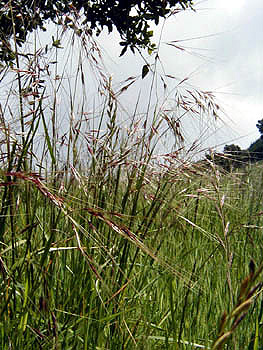
Purple
needlegrass (Nassella pulchra) This
perennial has a 3- to 10-dm. (12- to 40-inch)
unbranched stem. It has an open 18- to 60-cm.
(7- to 231/2-inch) panicle-like inflorescence.
The single floret per spikelet has a distinctive
38- to 100-mm. (11/2- to 4-inch) awn that is
strongly bent, except the tip which is straight.
The awn is stouter than that of Nasella lepida,
above. Purple needlegrass is found in grasslands,
oak woodlands, and chaparral.
Nasella
derives from the Latin word nassa meaning
"basket with a narrow neck." Pulchra
means "beautiful."
|
|
image
unavailable
One-sided
bluegrass (Poa secunda) This is a
perennial, densely clumped grass with 11/2 to
10 dm. (6- to 40-inch) culms. The leaf blade
is flat to folded or inrolled. The open to dense,
panicle-like inflorescence is 2 to 15 cm. (3/4
to 6 inches) long and is often one-sided. It
is linear to lanceolate in shape. The oblong
to linear spikelets are 6 to 10 mm. (1/4 to
1/2 inch) long and have three to six florets
each. The bracts of the spikelet are all awnless.
One-sided bluegrass is common in many habitats.
Poa
is the ancient Greek name. Secunda means
"inferior."
|
|
image
unavailable
Annual
fescue (Vulpia microstachys) This
grass is a loosely clumped or solitary annual.
It is erect or ascending to between 11/2 and
71/2 dm. (6 and 30 inches) tall. The stems are
glabrous and unbranched. The leaves have flat
blades (rolled when dry). The 2- to 24-cm. (3/4-
to 91/2-inch) panicle-like inflorescence has
lower branches spreading. The 51/2- to 10-mm.
(1/4- to 1/2-inch) spikelet stalk is angular.
Each spikelet has two to four florets each with
a 31/2- to 12-mm. (1/8- to 1/2-inch) awn. Annual
fescue is common on disturbed, open, sandy soils.
J.S.
Vulpius was a pharmacist, botanist in Baden,
Germany. Microstachys means "small spike."
|
Descriptions
of Poly Canyon's common introduced grasses follow.
|
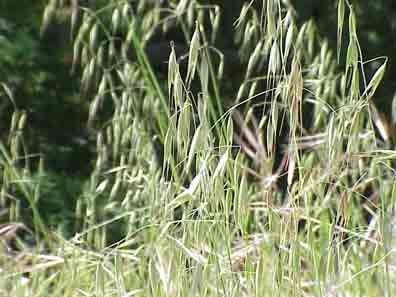
*Slender wild oat (Avena barbata)
This annual has culms that measure 3- to 6-dm.
(12- to 24-inch) - often much taller. It has
an open, panicle-like inflorescence. The spikelets
are usually two-flowered. Each floret has one
awn that is 20 to 40 mm. (3/4 to 11/2 inches)
long that emerges from the back of the lemma
more or less at the midpoint. The tips of the
lemmas have a pair of bristle-like teeth. The
awn is twisted below its bend. The pedicels
are very soft, so the fruits dangle. This grass
is common where the ground has been disturbed.
It has been introduced from southern Europe.
Avena
is Latin for "oats." Barbata means "bearded,"
referring to the hairiness of the lemmas.
|
|
image
unavailable
*Common
wild oat (Avena fatua) This annual
has 3- to 12-dm. (12- to 47-inch) culms. It
has a panicle-like inflorescence. The spikelets
are usually three-flowered. Each floret has
one awn that is 25 to 40 mm. (1 to 11/2 inches)
long that emerges from the back of the lemma
more or less at the midpoint. The tips of the
lemmas have a pair of short triangular teeth.
The awn is twisted below its bend. The pedicels
are more rigid than in A. barbata, so the fruits
are better supported. Common wild oat often
grows in disturbed sites. It has been introduced
from Europe.
Avena
is Latin for "oats." Fatua means "gaping."
|
|
image
unavailable
False
brome (Brachypodium distachyon) This
annual has decumbent to erect 15- to 40-cm.
(6- to 16-inch) culms with flat blades. A field
recognition feature is that the stem nodes are
hairy, whereas the internodes are glabrous.
False brome has a spike-like inflorescence of
1 to 8 cm. (1/2 to 3 inches). There are one
to six sessile spikelets on each stem. Each
spikelet has six to 20 florets. Each floret
has one terminal awn of 4 to 11 mm. (1/8 to
1/2 inch). False brome occurs in disturbed areas
and on dry slopes. It comes from southern Europe.
Brachypodium
is Greek for "short foot," referring to the
short, thick spikelet stalk in some species
of this genus. Distachyon means "two-pointed."
|
|
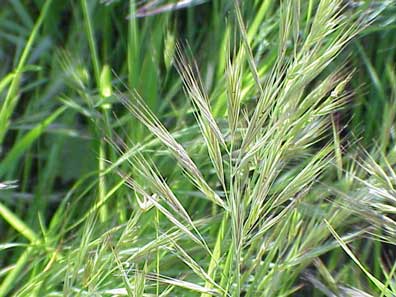
Ripgut
brome (Bromus diandrus) This 15-
to 80-cm. (6- to 32-inch) annual has soft-hairy
leaves. The 6- to 25-cm. (21/2- to 10-inch)
inflorescence is panicle-like and open and bears
a somewhat compressed spikelet. Each spikelet
bears five to eight florets. Each floret has
a single awn, 30 to 55 mm. (1 to 2 inches) long.
Ripgut brome occurs in open, disturbed places
and fields. It comes from Europe.
Bromus
is the ancient Greek name. Diandrus means
"having two stamens."
|
|
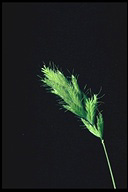
Soft
chess brome (Bromus hordeaceus) This
annual has 11- to 65-cm. (41/2- to 251/2-inch)
culms with soft-hairy leaves. The dense, somewhat
compressed 21/2- to 13-cm. (1- to 5-inch) inflorescence
bears one to many short hairy spikelets with
five to ten florets. Each floret has a single
awn, 4 to 10 mm. (1/8 to 1/2 inch) long. Soft
chess brome is found in open, often disturbed
places. It comes from Eurasia.
Bromus
is the ancient Greek name. Hordaceus
means "barley-like."
|
|
image
unavailable
Red
brome, foxtail chess (Bromus madritensis
ssp. rubens) This annual grows to 10
to 50 cm. (4 to 20 inches) tall. It has puberulent
to short-soft-hairy blades. The 3- to 8-cm.
(1- to 41/2-inch) dense, panicle-like inflorescence
bears cylindric to slightly compressed spikelets,
each with three to nine florets. Each floret
has a single 10- to 25-mm. (1/2- to 1-inch)
awn. Red brome occurs in open, generally disturbed
places. It was introduced from Europe.
Bromus
is the ancient Greek name. Madritensis
means "from Madrid." Rubens means "becoming
reddish."
|
|
image
unavailable
Nit
grass (Gastridium ventricosum) This
slender, erect annual has 1- to 4-dm. (4- to
16-inch) mostly glabrous culms. Leaves have
narrow, flat, or inrolled blades. The panicle-like,
11/2- to 9-cm. (1/2- to 31/2-inch) inflorescence
is very narrow and dense. Each spikelet has
one floret with a straight to curved, 3- to
5-mm. (1/8-inch) awn. Nit grass is found in
open, dry, disturbed places. It was introduced
from Europe.
Gastridium
is Greek meaning "small pouch," referring to
the swollen base of the spikelet. Ventricosum
comes from venter, "belly," and means
"swollen, inflated."
|
|
image
unavailable
Mediterranean
barley (Hordeum marinum ssp. gussoneanum)
This 1- to 5-dm. (4- to 20-inch) annual has
stems that are erect or bent at the base. The
blades range from flat to somewhat rolled. The
dense, spike-like, 11/2- to 7-cm. (1/2- to 21/2-inch)
inflorescence is green to purple in color. There
are three spikelets per node. There are two
types of spikelets: the central one has a single
bisexual floret. This floret has a 6- to 18-mm.
(1/4- to 1/2-inch) awn. Each of the two lateral
spikelets has a sterile floret with a 3- to
8-mm. (1/8- to 1/2-inch) awn . Hordeum marinum
flowers later in the season than does H.
murinum. Mediterranean barley occurs in
dry to moist disturbed sites. It is native to
Europe.
Hordeum
is the ancient Latin name. Marinum means
"of the sea, marine." The derivation of gussoneanum
is unclear.
|
|

*Foxtail
(Hordeum murinum) This is a 1- to 11-dm.
(4- to 431/2-inch) grass with erect (sometimes
prostrate) stems. The leaf blade ranges from
flat to somewhat rolled. The 3- to 8-cm. (1-
to 3-inch) green-glaucous inflorescence has
three spikelets per node. There are two types
of spikelets: the central one has a single bisexual
floret with a 20- to 40-mm. (1- to 11/2-inch)
awn. The lateral spikelets have a single floret
with a 20- to 50-mm. (1- to 2-inch) awn. Hordeum
murinum usually flowers earlier in the season
than does H. marinum. Foxtails are found
in moist, disturbed sites. Subspecies glaucum
is a summer annual. Subspecies leporinum
and murinum are winter annuals. Foxtails
were introduced from Europe.
Hordeum
is the ancient Latin name. Murinum means
"(gray) like a mouse."
|

*Wild
rye, Italian ryegrass (Lolium multiflorum)
This is an annual in Poly Canyon. Its solitary
to loosely clumped stems are 4 to 8 dm. (16
to 32 inches) long, and are generally glabrous.
The leaves are basal and cauline. The 5- to
20-cm. (2- to 8-inch) blade is rolled when
in bud. The spike-like, 10-to 30-cm. (4- to
12-inch) inflorescence has sessile, laterally-compressed
spikelets inserted edge-on to the axis of
the spike. Each spikelet has a single basal
glume. There are five to 20 bisexual florets
per spikelet. Each floret has a single 1-
to 8-mm. (1/16- to 1/4-inch) awn. Wild rye
is found in disturbed sites. It was introduced
from Eurasia.
Lolium
is the ancient Latin name for "ryegrass." Multiflorum
means "many-flowered."
|
|
image
unavailable
Harding
grass (Phalaris aquatica) This is
a 4- to 15-dm. (16- to 59-inch) perennial clumping
grass. It has erect stems with flat-bladed leaves.
The very dense inflorescence is 11/2 to 11 cm.
(1/2 to 41/2 inches) long, panicle-like, and
cylindric or ovoid in shape. The strongly compressed
spikeletshave a single, terminal fertile floret
and one or two tiny sterile lemmas below it.
Harding grass is common in wet areas and ditches.
It was introduced from Mediterranean Europe.
Phalaris
is the ancient Greek name for "grass with shiny
spikelets." Aquatica means "found in/near
water."
|
|
image
unavailable
Smilo
grass (Piptatherum miliaceum) This
is a perennial, clumping grass. The culms are
4 to 15 dm. (151/2 to 59 inches) tall. The open
15- to 40-cm. (6- to 151/2-inch) inflorescence
has whorled branches with numerous tiny spikelets.
Each spikelet has a single floret that is 11/2
to 2 mm. (1/16 to 1 inch). The slightly bent
awn is 3 to 4 mm. (1/8 inch) and falls readily.
Smilo grass is found in disturbed places, mostly
along the roadsides in Poly Canyon. It was introduced
from Eurasia.
Piptatherum
means "falling awn" in Greek. Miliaceum
means "millet-like."
|
|
image
unavailable
Annual
bluegrass (Poa annua) This is an
annual, 2- to 20-cm. (1- to 8-inch) grass. It
forms clumps or spreads by stolons. The leaf
blade is flat and is bright or yellowish green.
The 1- to 10-cm. (1/2- to 4-inch) inflorescence
is panicle-like with spreading branches.The
3- to 6-flowered, oblong spikelets are 3- to
6-mm. (1/8- to 1/4-inch) long. The bracts of
the spikelet are all awnless. Annual bluegrass
grows in disturbed, moist ground. It is native
to Europe.
Poa
is the ancient Greek name. Annua means
"annual."
|
|
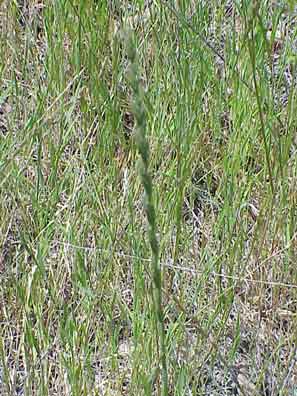
Rattail
fescue (Vulpia myuros) This annual,
loosely clumped or solitary stemmed grass is
unbranched and less than 71/2 dm. (30 inches)
tall. The dense, panicle-like inflorescence
measures 4 to 25 cm. (11/2 to 10 inches) in
length. The spikelet stalk is slender, and the
spikelet is 5 to 111/2 mm. (2 to 41/2 inches)
long. Each spikelet bears three to six florets,
each with a 5- to 15-mm. (1/4- to 1/2-inch)
awn. This grass occurs in open, sandy places,
hillsides, and moist sites in chaparral. It
was introduced from Europe.
J.S.
Vulpius was a pharmacist, botanist in Baden,
Germany. Myuros means "long and tapering,
like a mouse's tail."
|
- Grassland
forbs include:
- *Wild
onion (Allium haematochiton, Liliaceae)
- *Fiddleneck,
rancher's fireweed (Amsinckia menziesii var.
intermedia, Boraginaceae)
- Locoweed
(Astragalus curtipes, Fabaceae)
-
- Cryptantha
(Cryptantha clevelandii, Boraginaceae)
- *Blue
dicks (Dichelostemma capitatum, Liliaceae)
- *Storksbill
filaree (Erodium botrys, Geraniaceae)
- *Redstem
filaree (Erodium cicutarium, Geraniaceae)
- *California
poppy (Eschscholzia californica, Papaveraceae)
- *Goldfields
(Lasthenia californica, Asteraceae)
- *Jones'
Layia (Layia jonesii, Asteraceae)
- *Tidy-tips
(Layia platyglossa, Asteraceae)
- *Baby
stars (Linanthus parviflorus, Polemoniaceae)
-
*Popcornflower (Plagiobothrys nothofulvus,
Boraginaceae)
- *Annual
plantain (Plantago erecta, Plantaginaceae)
- *Buttercup
(Ranunculus californicus, Ranunculaceae)
-
*Blue-eyed grass (Sisyrinchium bellum, Iridaceae)
-
*Johnny jump-up (Viola pedunculata, Violaceae)
Grassland
forbs are described here:
|
image
unavailable
*Wild
onion (Allium haematochiton, Liliaceae)
This perennial spreads by bulbs on short rhizomes.
The stem is 10 to 40 cm. (4 to 16 inches) tall.
The four to six flat, linear, basal leaves wither
from the tip before the plant blooms. The inflorescence
is an umbel of ten to thirty flowers. The flowers
are 6 to 8 mm. (1/4 inch), with the three sepals
and three petals being petal-like. The flowers
are whitish to rose-colored and have a dark
mid-vein. The six stamens are epipetalous. The
bloom is from March through May. Wild onion
is common on grassy, dry, rocky hillsides.
Allium
is Latin for "garlic." Haematochiton
refers to the reddish, stiff, papery membranes
enveloping the bulbs.
|
|

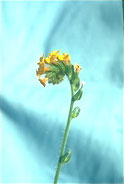
*Fiddleneck,
rancher's fireweed (Amsinckia menziesii
var. intermedia, Boraginaceae) This 20-
to 120-cm. (8- to 47-inch) annual is bristly.
It has both basal and alternate cauline leaves.
The inflorescence is a cluster of spike-like
scorpioid cymes. The 1/2-cm. (1/4-inch) flowers
are deep yellow to orange. They are tubular,
flaring at the mouth. They bloom from February
through May. The fruits are clusters of one-seeded,
tubercled, three-angled nutlets. Fiddlenecks
are common in open and generally disturbed places.
This is a native species.
W.
Amsinck, 19th century, was a patron of the Hamburg
Botanical Garden, Germany. Archibald Menzies
(1754-1842) was a naturalist on the Vancouver
Expedition. Intermedia means "intermediate."
|
|
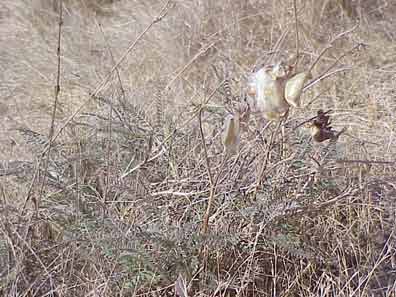
Locoweed
(Astragalus curtipes, Fabaceae) This
perennial has clumped 20- to 40-cm. (8- to 16-inch)
tomentose stems. The pinnately compound leaves
have between 25 and 39 leaflets. The inflorescence
is a dense raceme with 15 to 35 flowers. The
petals are cream-colored, with the keel possibly
lilac tinged at the tip. Blooms occur from January
through June. The fruit is a 21/2-to 4-cm. (1-
to 11/2-inch) one-chambered, papery bladder
(legume). Locoweed is found in grasslands, as
well as shrublands and disturbed places. This
is a native species. Alkaloids in this plant
are TOXIC.
Astragalus
is Greek meaning "ankle bone" or "dice," possibly
referring to the rattling of seeds inside the
pod. Curtipes means "short foot," referring
to the short stalk or stipe at the base of the
ovary.
|
|
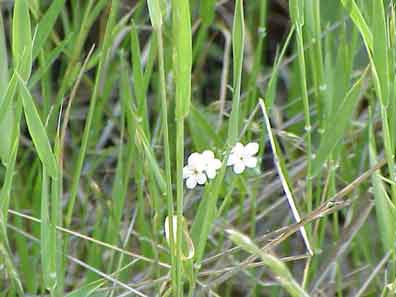
Cryptantha
(Cryptantha clevelandii, Boraginaceae)
Cryptantha is a 10- to 60-cm. (4- to 24-inch)
annual covered with fine, appressed hairs. It
has simple to branched basal leaves and cauline
leaves that are opposite low on the stem, alternate
higher up. The inflorescence is a cluster of
dense, terminal, scorpioid cymes of tiny white
flowers that bloom from March through July.
The fruit is usually a single nutlet (occasionally
two to four nutlets). The nutlet is lanceolate-ovate,
smooth, shiny, and mottled gray-brown. Cryptantha
can be found in sandy or rocky (even serpentinite)
soils, including chaparral. This species is
native.
Cryptantha
is Greek meaning "hidden flower." This refers
to the fact that some species have cleistogamous
flowers (that remain closed and are usually
self-fertilizing). Daniel Cleveland (1838-1929),
of San Diego, collected extensively in southern
California as well as the eastern United States.
|
|
image
unavailable
*Blue
dicks (Dichelostemma capitatum, Liliaceae)
This perennial wildflower spreads by corms.
It has two or three basal leaves measuring 10
to 40 cm. (4 to 16 inches). The inflorescence
is a dense head or umbel on a bare stem that
grows to 65 cm. (2 feet) tall, with dark purple
bracts, and six to fifteen flowers. The flowers
are bell-shaped. They have three sepals and
three petals all petal-like, in two series.
They are light bluish purple in color (sometimes
white or pinkish purple). The flower tube measures
3 to 12 mm. (1/8 to 1/2 inch). There are six
stamens which are fused to the perianth and
into a crown-like tube. Blooms appear February
through May. The fruits are three-angled capsules.
Blue dicks are common in grasslands, scrublands,
and open woodlands.
Cacomite
bulbs were roasted and eaten by native Californians.
Dichelostemma
is Greek meaning "toothed crown," referring
to the appendages on the stamens. Capitatum
refers to the dense head-like inflorescence.
|
|
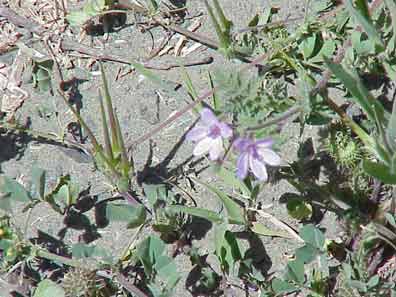
*Storksbill
filaree (Erodium botrys, Geraniaceae)
This is a 10- to 90-cm. (4- to 35-inch) prostrate
to ascending annual. Its stems have many short
hairs. The leaves are lobed or dissected. The
flowers are maroon-veined and pink-lavender
overall. They bloom from March through May.
The 5-lobed fruit has a 5- to 12-cm. (2- to
5-inch) long stout beak and breaks into five
pieces at maturity; the segments of the beak
coil into a tight spiral as they dry. Storksbill
filaree occurs in dry, open, and distrubed places.
The plant is native to southern Europe.
Erodium
is Greek for "heron," referring to the bill-like
fruit. Botrys is Greek and means "bunch
of grapes."
Alfilerillo
("little needle" in Spanish) was introduced
early in the Mission period. Its seeds were
used for food; the plant was boiled to make
a tonic for the blood.
|
|
image
unavailable
*Redstem
filaree (Erodium cicutarium, Geraniaceae)
This is a 71/2- to 30-cm. (3- to 12-inch) annual
with glandular hairy stems. Its leaves are compound,
hairy, and deeply dissected. The 0.25-inch flowers
are magenta with a purple base. They bloom from
February through May. The fruit has a shorter
beak than that of E. botrys, 2 to 5 cm (3/4
to 2 inches). Redstem filaree occurs in open
and disturbed places, in shrublands and grasslands.
This plant is native to Europe.
Erodium
is Greek for "heron," referring to the bill-like
fruit. Cicutarium derives from the Latin
cicuta which means "poison hemlock,"
referring to the dissected margins of the leaves.
|
|
image
unavailable
*California
poppy (Eschscholzia californica,
Papaveraceae) This annual (or perennial, from
a taproot) grows to 60 cm. (2 feet) tall. Its
glaucous, linear-dissected leaves are basal
as well as scattered along the stem. The flower
bud is upright, acute, and may be glaucous.
As the flowers open, the cone-like calyx is
pushed off by the expanding petals. The four
2- to 51/2-cm. (3/4- to 21/2-inch) petals are
a brilliant golden yellow with the bases tinged
orange. The bloom is from February through September.
The flowers become smaller in late-flowering
plants. The fruit is a 3- to 9-cm. (11/4- to
31/2-inch), cylindric capsule that splits open
lengthwise. The California poppy is found in
open, grassy and disturbed places. California
poppy is a native species.
J.F.
Eschscholtz, 1793-1831, was a Russian naturalist.
Californica means "of California."
Toroza
was used by native Californians as an analgesic
for colic. It was one of the mythological elements.
Now it is our state flower.
|
|
image
unavailable
*Goldfields
(Lasthenia californica, Asteraceae) This
is an annual that grows to about 40 cm. (16
inches) tall (but usually less in Poly Canyon).
It has a hairy stem that is simple or branched.
The needle-like leaves are opposite. The inflorescence
is a small terminal daisy-like head of 10 to
14 deep yellow ray florets and many creamy yellow
disk florets that bloom in March and April.
Goldfields occur in a variety of habitats, especially
in open, grassy areas. En masse it colors
grassy fields a brilliant golden yellow - hence
the common name. This is a native species.
Lasthenia
was a female student of Plato. Californica
means "of California."
|
|
image
unavailable
*Jones'
Layia (Layia jonesii, Asteraceae)
This is a 7- to 55-cm. (23/4- to 22-inch) glandular,
unscented annual. Its linear to (ob)lanceolate,
lobed leaves are less than 7 cm. (23/4 inches)long.
Its flowers are in terminal daisy-like heads.
The 4- to 8-mm. (1/6- to 1/3-inch) phyllaries
appear swollen at base (unlike tidy-tips (L.
platyglossa), below). There are 13 to
27 white-tipped yellow ray florets. Disk florets
number 35 to 100 and have purple anthers. The
fruits of the ray florets are shiny; those of
disk florets usually have a pappus of scales
(which readily distinguishes this species from
tidy-tips (L. platyglossa), below). Jones'
Layia is a rare species, but is common in Poly
Canyon, particularly on open serpentinite or
clay slopes. It is a native species.
G.T.
Lay, early 19th century, was an English plant
collector. Marcus E. Jones was a botanist collector
in the late 1800s and early 1900s.
|
|
image
unavailable
*Tidy-tips
(Layia platyglossa, Asteraceae) This
is a 3- to 70-cm. (11/4- to 28-inch) glandular,
unscented annual. Its linear to (ob)lanceolate,
lobed leaves are 4- to 100-mm. (1/6- to 1/2-inch)
long. The flowers are in terminal daisy-like
heads. The 4- to 18-mm. (1/6- to 3/4-inch) phyllaries
do not appear swollen at base (unlike Jones'
Layia (L. jonesii), above). The 5 to
18 ray florets are deep yellow and usually tipped
neatly in white. The disk florets are yellow
with generally purple anthers. They bloom from
March through May. Fruits from ray florets are
dull; those of disk florets have a pappus of
bristles (another feature which distinguishes
this species from Jones' Layia (L. jonesii),
above). Tidy-tips are common in Poly Canyon
and widespread in many habitats, especially
grasslands. This is a native species.
G.T.
Lay, early 19th century, was an English plant
collector. Platyglossa means "flat tongue."
|
|
image
unavailable
*Baby
stars (Linanthus parviflorus, Polemoniaceae)
This annual wildflower grows 5 to 25 cm. (2
to 10 inches) tall. Its 8- to 25-mm. (1/4- to
1-inch) leaves are very deeply lobed. They are
arranged on the stem opposite one another. The
terminal, head-like inflorescence contains sessile
flowers. The flowers have a 6- to 8-mm (1/4-inch)
calyx and a salverform corolla the thread-like
tube of which is 20 to 35 mm. (3/4 to 11/4 inch)
long. The corolla tube can be maroon, pink or
yellow, the throat is yellow, the lobes are
5 to 6 mm. (1/4 inch), oblong, and can be white,
pink, yellow, blue, or purple and have red marks
at their base. Baby stars bloom in April and
May. They are found in many habitats, open and
wooded.
Linanthus
is Greek and means "flax flower." Parviflorus
means "small flower."
|
|
image
unavailable
*Popcornflower
(Plagiobothrys nothofulvus, Boraginaceae)
This is a 20- to 71-cm.(8- to 28-inch) bristly-hairy
annual. It has purple sap. Its leaves are arranged
in a basal rosette with a few along the stem.
The inflorescence is a cluster of elongated
scorpioid cymes of tiny white flowers that bloom
from March through May. The fruit is a cluster
of one to three (or four) round to ovoid nutlets.
Each nutlet has a round scar on the side near
the middle. Popcornflower occurs in grasslands
and woodlands. From a distance, the clusters
of white flowers resemble puffs of popcorn scattered
in the grass. This is a native species.
Plagiobothrys
is Greek and means "sideways pit." This refers
to the attachment scar on the nutlet. Nothus
means "not genuine, counterfeit, illegitimate."
Fulvus means "tawny, bronze, red-brown,
yellow-brown."
|
|

*Annual
plantain (Plantago erecta, Plantaginaceae)
This is a slender, erect, softly hairy annual.
Its 21/2- to 12-cm.(1- to 5-inch) leaves are
all basal; they are thread-like to oblanceolate.
The 21/2- to 30-cm. (1- to 12-inch) hairy inflorescence
is a densely flowered head-like or short-cylindric
shaped spike. The tiny, 4-petalled, radial flowers
are bisexual. They bloom from March through
May. The fruit is a capsule. Annual plantain
is found in sandy, clay, or serpentinite soils,
on grassy slopes and flats, and in open woodlands.
This is a native species.
Plantago
is Latin for "sole of the foot" or "footprint."
Erecta means "upright."
|
|
image
unavailable
*Buttercup
(Ranunculus californicus, Ranunculaceae)
This 30- to 60-cm. (1- to 2-foot) wildflower
is an erect to spreading, tap-rooted perennial.
The flowers are shiny bright yellow with nine
to 16 petals and many stamens. The shininess
of the petals is starch which turns bluish-purple
when scarred with ones fingernail. Buttercups
bloom from February through April. The fruit
is a cluster of achenes. Buttercups are found
in grasslands and oak woodlands. They are native.
Ranunculus
is Latin for "little frog," probably referring
to the flower's moist habitat. Californicus
means "of California."
|
|
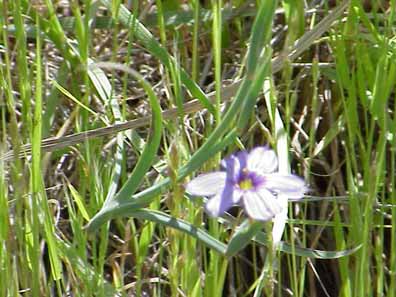
*Blue-eyed
grass (Sisyrinchium bellum, Iridaceae)
This is a perennial with compact rhizomes. Its
30-cm. (12-inch) stems are branched and somewhat
flattened. The basal, grass-like leaves appear
to be attached edge-on to the stems. The deep
blue-purple 2- to 21/2-cm. (3/4- to 1-inch)
flowers have yellow centers. They bloom from
March through June. The fruit is a dry capsule.
Blue-eyed grass is found on open, moist, grassy
hillsides and in woodlands. It is a native species.
Sisyrinchium
was so named by the Greek naturalist Theophrastus,
372-287 B.C. Bellum means "pretty" or
"beautiful."
Spaniards
called blue-eyed grass azulea for its
blue color.
|
|
image
unavailable
*Johnny
jump-up (Viola pedunculata, Violaceae)
This is a 10- to 36-cm. (4- to 14-inch) perennial.
Its heart-shaped leaves are mostly basal. They
are edged in coarsely rounded teeth. The flowers
are on 12- to 15-cm. (5- to 6-inch) stalks and
have five bright yellow petals with dark markings
at the base. The uppermost two petals are tinged
in brown outside. The lowest petal is spurred
at its base. The blooms appear from February
through April. The fruit is a capsule. Johnny
jump-ups are common in open, grassy areas, as
well as chaparral and woodlands. They are native.
Viola
is the classical name. Peduculata refers
to the prominent flower stalks (peduncle).
The
local Spanish name was gallitos, meaning
little roosters, for their coloring.
|
|